Food and Putting Down Roots

MY FIRST POST
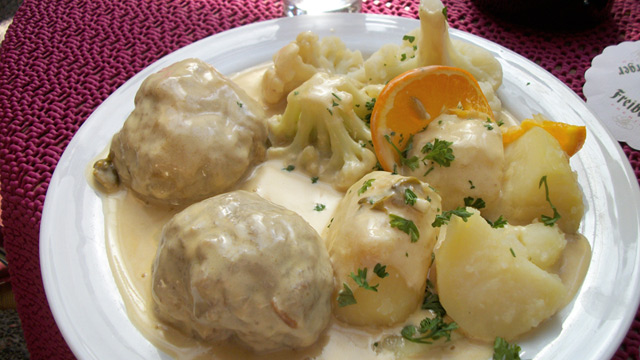
Konigsberger klopse - german meatballs in creamy caper sauce
Regardless of the complexity of the immigration situation in Europe, one clear contribution of immigrants in France, Germany and England is cheap good eats. Turkish, Vietnamese, Thai, Indian, and pseudo- Japanese eateries dot city blocks. For myself, foreign fare tends to have a bit more of my daily vegetable intake than the local fare. The spunkier flavours are also a welcome change for extended European visits (especially in England). No one can take France’s culinary medals from them, but for inexpensive French cuisine, it really is hit and miss. France’s culinary reputation has given them license to rape tourists, on occasion serving them food that is shabby by North American standards. (Tiens!) Yet many French, Italians and Spaniards retain their chauvinistic approach to food. Some know and care only to know local and national food. In what are supposed to be modern transient societies and were the birthplace of colonialism and the mass spread of culture, people and social systems around the world, the frequent lack of interest in other culinary traditions is shocking. When Italians get off the plane in Tunisia and immediately start looking for pizza- this is a problem.
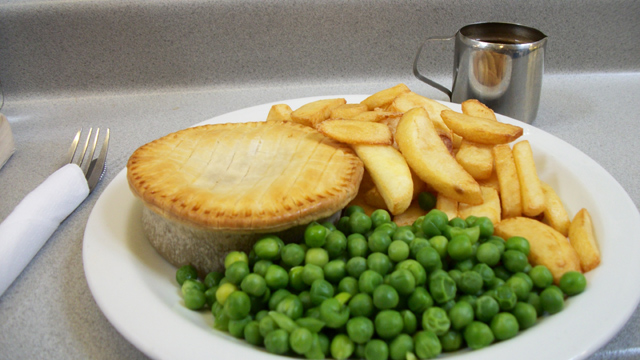
Steak and kidney pie with green peas and chips in London.
Food is very emotional and we connect it to our moms and grandmas and it is key in our cultural identity, whether it be a pure or a melting pot identity. It is normal to be attached to one’s gastronomic traditions, yet I saw a delicious example of where two cultures met on a middle-ground. Resolving cultural differences by planting roots in the here and now in new cultural realities and using food as the medium, well- that’s amazing!
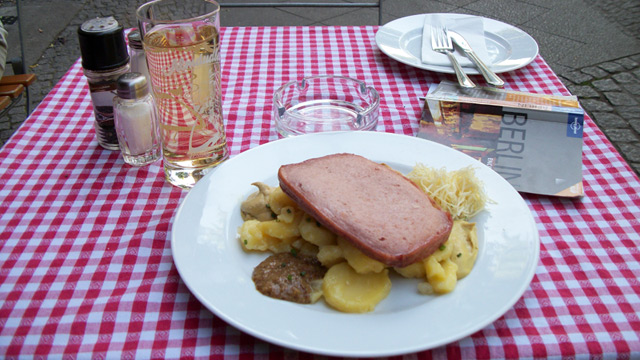
Wiener like sausage loaf with potato salad, fresh horseradish, 3 mustard's and a spritzer.
When I was in Berlin, I had a dream about poaching a duck breast and then slicing it thinly. In my dream I was very anxious about the whole process and how it should be served. Don’t ask me what the dream means, I do not know! The next day, after some fun-filled hours of visiting museums documenting the suffering caused by over-zealous government/army regimes, I stopped in to a roadside Thai/Vietnamese/Chinese shack for a bit of respite from Europe’s heavy history. The establishment was an orange snack trailer with a bamboo fenced in terrace, and a nice calming breeze, just there- or so it seemed! It felt like an oasis in the dessert. All the clients were Germans- original ethnic Germans, no immigrants- first, second or whatever generation- just Germans. One of my favourite things about ordering in a country where you don’t speak the language is ordering a random item off the menu and getting a total surprise. I settled on number 30 Knusprig ente under the section Ente-Gerichte. It was described as follows:abgeschmeckt mit basilicum, zitrongras, kokomilch, gruen, bohnen und rotem curry dazu Duftreis. Okay, I’m not completely ridiculous, I knew there was basil, lemongrass and coconut milk in it. After an eager and short wait, delivered to my table was a schnitzel-style (breaded and fried) piece of meat, sliced thinly laying delicately on a bed of creamy curried vegetables with a little temple of rice next to it. I picked-up one of the pieces of meat with my chopsticks, oggled it and noticed it was somewhat dark,… doesn’t look like pork. I took a bite and the texture was like poultry, but not chicken, much more flavourful…Oh my goodness, I got a breaded fried duck breast with vegetables for 5.50 €! Get out! The duck was a schnitzel-style interpretation of Southeast Asian breaded and fried meat… but it was really good. The curry had this kind of synthetic- Knorrish type of flavour and wasn’t very spicy, but it was also very nice. I looked around and saw the calm of other satisfied customers. Neither German nor South East Asian food is supposed to be like this; some elements were toned-up, while some toned-down but the compromise was really good. The lack of purity did not seem to pose a threat to any of the others eating…why should I care? I remembered my dream and felt this was an answer to my dream-time duck anxiety (I still don’t really know what it means.)
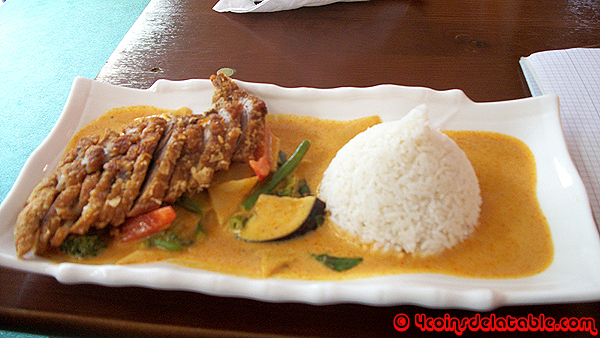
Knusprig ente - crispy duck with curried vegetables and rice
Knusprig ente – crispy duck with curried vegetables and rice
This seemed to be an answer to the intolerance question. For a new-arrival to integrate local traditions into his culinary practice is a great step towards leaving behind one’s past life. This dish was about embracing change and living one’s reality, weaving the best of both worlds together…and for 5.50€ , come on. You take the fried meat you made at home, but then you try it the way the people make it where you are. Do the same with the sauce and serve it back to them. That’s what exchange is! You take your original premise, modify elements of it with ideas you take from another tradition and then give it back to them as a gift. Everyone is happy! The customers were happy… and many. The men working there had a lightness and joy about them and were living it up in the new-life . They all waved eagerly and with pride when they saw me trying to take a photo of their roadside stand on the sly. They were enjoying the best of both worlds. They weren’t sinking with purist rigidity; they were rising above, transcending, transmuting the heaviness of the many close-minded.
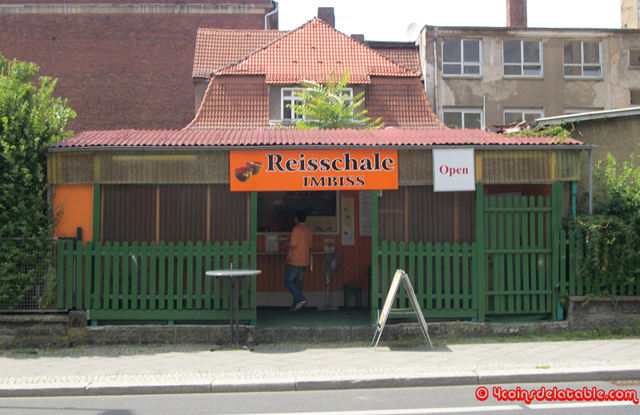
Inbis Reisschale Berlin chain
This dining experience was also unlike the dumpy Chinese restaurants in Montréal that serve a worst of both worlds rendition of Chinese food because they don’t think Canadians ‘can handle it’. It also wasn’t the super-segregated all-Japanese or all-Chinese restaurants in Vancouver where everyone turns and looks at you with gaping-mouth if you cross the invisible border and actually come in to see what’s going on on the other side.
Sampling the gastronomic fare of other cultures and sharing yours with them is a way of ingesting traditions, and the common sensory and nutritional experience of a people. People are proud of their food. When you taste the food of an up-rooted immigrant, you can at least appreciate that they ‘are not from here’. They have their own baggage and know-how, and they try to recreate what they know without having all of the same ingredients. It’s hard to cook up an identity- one that works, one that you feel good about, It’s also hard to mix in new unacquainted ingredients, but usually with trial, error and a little common sense you can make it work with what you have. Kudos to the roadside Buddhas and the high-end foodies around the world that find a way to use food to bridge the gap.
Note
The restaurant is called Imbiss Reisschale and there are different locations around Berlin, but the one I ate at was at 68 Ruschestraße, Berlin.
Little Facts
Knusprige Ente- is what we would call “Crispy Duck” in English. In Chinese cooking, the duck is usually cooked with aromatics and then fried without being breaded. In German cooking Schnitzel is a piece of white meat- veal or pork- that is pounded until thin, coated in bread crumbs and then fried.
Challenge
I challenge you to do you own crispy duck- rubbed and cooked with the aromatics you like- maybe anise, ginger, scallions, garlic and then breaded in the style you like and fried- beer batter, panko, egg, flour and soft bread crumbs- as you wish. What is your reality?
No related posts.
CATEGORIES
Archives
- February 2022 (1)
- October 2020 (2)
- September 2020 (1)
- January 2016 (1)
- January 2015 (1)
- October 2014 (1)
- February 2014 (1)
- January 2014 (1)
- July 2013 (1)
- June 2013 (2)
- May 2013 (1)
- March 2013 (1)
- February 2013 (2)
- November 2012 (1)
- September 2012 (1)
- June 2012 (2)
- May 2012 (1)
- April 2012 (1)
- March 2012 (1)
- February 2012 (1)
- January 2012 (2)
- December 2011 (1)
- November 2011 (4)
- October 2011 (4)
Popular Tags
'Round Table Tours Asian breakfast business prolfiles cabbage canning Community Europe Events farms fermentation Fitz & Follwell Food & Story Food history Food Production food tours fresh juices Friends gastronomy health herbs History Italy kimchi Meal exchange Nuart organic preserves public Quebec restaurant Rumble & Shakes Réseau d`Entraide de Verdun salt smoothies spicy Tours de la Table Vegan youtube videos


